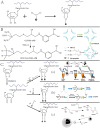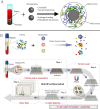Application of nanomaterials in proteomics-driven precision medicine
- PMID: 35401834
- PMCID: PMC8965478
- DOI: 10.7150/thno.64325
Application of nanomaterials in proteomics-driven precision medicine
Abstract
Nanostructured devices and nanoparticles have fundamentally reshaped the development of precision healthcare in recent decades. Meanwhile, mass spectrometry (MS)-based proteomics has evolved from simple protein sequencing to a powerful approach that identifies disease patterns and signatures, reveals molecular mechanisms of pathological processes, and develops therapeutic or preventive drugs. Significantly, the two distinct disciplines have synergized and expanded our knowledge about human health and disease, as evidenced by a variety of nanotechnology-assisted sample processing strategies, facilitating in-depth proteome profiling and post-translational modifications (PTMs) characterization. This review summarizes recent advances in nanoparticle design for better enrichment of marker proteins and their PTMs from various bio-specimens and emerging nanotechnologies that are applied to MS-based proteomics for precision medicine discovery.
Keywords: Nanoparticle; biomarkers; mass spectrometry; nanotechnology; post- translational modifications; proteomics.
© The author(s).
Conflict of interest statement
Competing Interests: The authors have declared that no competing interest exists.
Figures




Similar articles
-
Mass spectrometry-based proteomics for system-level characterization of biological responses to engineered nanomaterials.Anal Bioanal Chem. 2018 Sep;410(24):6067-6077. doi: 10.1007/s00216-018-1168-6. Epub 2018 Jun 8. Anal Bioanal Chem. 2018. PMID: 29947897 Free PMC article. Review.
-
Novel Strategies to Address the Challenges in Top-Down Proteomics.J Am Soc Mass Spectrom. 2021 Jun 2;32(6):1278-1294. doi: 10.1021/jasms.1c00099. Epub 2021 May 13. J Am Soc Mass Spectrom. 2021. PMID: 33983025 Free PMC article. Review.
-
Advances in enrichment methods for mass spectrometry-based proteomics analysis of post-translational modifications.J Chromatogr A. 2022 Aug 16;1678:463352. doi: 10.1016/j.chroma.2022.463352. Epub 2022 Jul 19. J Chromatogr A. 2022. PMID: 35896048 Review.
-
Characterizing disease-associated changes in post-translational modifications by mass spectrometry.Expert Rev Proteomics. 2018 Mar;15(3):245-258. doi: 10.1080/14789450.2018.1433036. Epub 2018 Feb 1. Expert Rev Proteomics. 2018. PMID: 29376447 Review.
-
Emerging mass spectrometry-based proteomics methodologies for novel biomedical applications.Biochem Soc Trans. 2020 Oct 30;48(5):1953-1966. doi: 10.1042/BST20191091. Biochem Soc Trans. 2020. PMID: 33079175 Free PMC article. Review.
Cited by
-
Panomics reveals patient individuality as the major driver of colorectal cancer progression.J Transl Med. 2023 Jan 23;21(1):41. doi: 10.1186/s12967-022-03855-0. J Transl Med. 2023. PMID: 36691026 Free PMC article.
-
Clinical glycoproteomics: methods and diseases.MedComm (2020). 2024 Oct 4;5(10):e760. doi: 10.1002/mco2.760. eCollection 2024 Oct. MedComm (2020). 2024. PMID: 39372389 Free PMC article. Review.
-
Oncogenic Proteomics Approaches for Translational Research and HIV-Associated Malignancy Mechanisms.Proteomes. 2023 Jul 4;11(3):22. doi: 10.3390/proteomes11030022. Proteomes. 2023. PMID: 37489388 Free PMC article. Review.
-
Towards Ideal Health Ecosystem With Artificial Intelligence-Driven Medical Services in India: An Overview.Cureus. 2023 Nov 8;15(11):e48482. doi: 10.7759/cureus.48482. eCollection 2023 Nov. Cureus. 2023. PMID: 38073925 Free PMC article. Review.
-
Nanomaterials with Excellent Adsorption Characteristics for Sample Pretreatment: A Review.Nanomaterials (Basel). 2022 May 27;12(11):1845. doi: 10.3390/nano12111845. Nanomaterials (Basel). 2022. PMID: 35683700 Free PMC article. Review.
References
-
- Ashley EA. Towards precision medicine. Nat Rev Genet. 2016;17:507–22. - PubMed
Publication types
MeSH terms
Substances
LinkOut - more resources
Full Text Sources
Miscellaneous

